
The problems with this movie begin even before you've taken the DVD out of the box: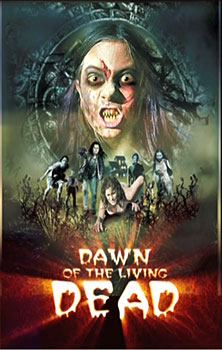 What could they have been thinking? George Romero's Dawn of the Dead is one of the few critically-acclaimed horror movies about the living dead, and it's one of an even smaller number of classic films that survived their early-21st century remakes with their dignity more or less intact. Dawn of the Dead is a stunning combination of satire and, well... gut-wrenching apocalyptic horror; if your film is going to reference Romero's in any way, you'd better be sure your own work holds up to the comparison. But to actually go so far as to steal the title...? And then, to apply it to a cheap little flick featuring five, count 'em five zombies menacing a virtually-uninhabited stretch of California desert...? What were they thinking?! (They were thinking some schmuck like me would consider that boneheaded title a personal challenge, and buy the DVD. And you know what? They were right, goddamn it. And now, here I am reviewing it. It makes me want to hang my head in shame.) Now, you can't really blame the movie's writer/ director/ producer/ star David Heavener for the wretched decision to call the movie Dawn of the Living Dead. He shot the film under the title Curse of the Maya — not the most inspiring of titles, it's true; but when you consider that the DVD title inspires only derision and contempt, then maybe "uninspiring" was the way to go. During the brief monologue that serves as the DVD's only Special Feature, Heavener sits under a large poster bearing the movie's original name, so it seems he was none too pleased with the distributor's decision either. But if we can't blame Heavener for the title... the stupid, stupid title for which the word "derivitive" simply isn't sufficient... there's still plenty of other things we can blame him for. Most of the rest of the movie, in fact. And that brings us to the second thing awry on the DVD box. Actor Todd Bridges is given top billing over the title, so you might think Todd Bridges has a fairly big role in the movie1. Actually, Bridges has a non-speaking part with less than five minutes on-screen... and I think these are five minutes he'd prefer to leave off his résumé. Many fine actors and actresses have played people who were mentally challenged, or who were developmentally disabled; but Bridges's "character" can't be dignified with any of those descriptions. With his dime-store hillbilly-teeth and his fake pot belly, Bridges is forced to play... to use the appropriate elementary school term... a ree-tard. Sorry; as painful as it is, there's no other word that fits. This is something Heavener has to answer for, in his role as the movie's writer. Fifty years ago, black actors in mainstream horror films had to play offensively broad ethnic stereotypes; now here's Bridges playing an offensively broad disability stereotype. Now that's Progress! 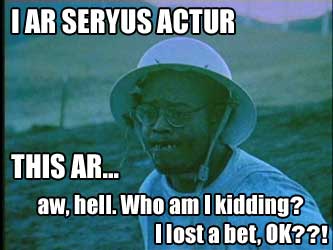 Finally, the pull-quotes on the box cover suggest that Dawn of the Living Dead is a sort-of horror comedy. It isn't. Most of it is serious almost to the point of dreariness. I have no doubt that people were laughing during the premiere, but not because it is intentionally funny. I don't want to give the impression that the movie is a total disaster. I also don't want to suggest that Heavener suffers from a lack of good ideas. For example, I'm grateful to him for calling attention to the fact that the Maya people still exist in places like Belize and Guatemala — though I suspect neither Mayan rights groups nor the Belize Tourist Board are going to like Heavener's take on their culture (fortunately, everybody's still so mad at Mel Gibson that they're probably not paying any attention...). Heavener also has a pretty good idea how to set up a shot, and some of his dialogue (though by no means all) turns out to be surprisingly nuanced. Rather, Heavener's problem is with the execution. His story quickly runs out of control, and sets rules for itself it is unable to stick to. All the elements are there for a reasonably enjoyable film, but the elements aren't enough. We've been promised a cake: instead, the baker hands us a bag of flour, a few eggs, a bottle of milk and an expired coupon for some sugar. There: was that simile dreadful enough? Yeah, well... it's better than anything a movie called Dawn of the Living Dead deserves, no matter what its working title might have been. See, there's a woman named Renee, and she and her... um... father? No; actually, it's her fiancé (the ubiquitous Joe Estevez), though we don't have this made clear to us until after we see them sleeping in the same bed. Ick. Anyway, she and her But no sooner has Renee started to settle in when she begins to have premonitions and bad dreams. For instance, she becomes convinced that a little girl is watching her from the nearby bushes. She follows a mysterious woman out behind a hill, and is amazed to find a corn field growing where no corn field should be. In particular, she has a vision of a family of five — a father, a mother, a heavily-pregnant daughter, a younger son and a little girl — being murdered outside the house. The pregnant girl is drowned in a pool, and the others are killed with a shotgun. In her vision, Renee sees the youngest daughter flee upstairs to the attic, where she has just enough time to draw a picture on the back of some wallpaper before the killer finds her. The vision is unsettling enough; but when Renee goes to get a look at the grounds, she's shocked to find they look exactly the way she saw them in her "dream". Even the abandoned clothes hanging on the clothesline are the same. When she goes to look through the rest of the house, she finds the attic looking very familiar, too (though mysteriously free of spattered blood). She comes running down with a fragment of wallpaper in her hand to tell Jeff what she's discovered... Except what she says makes very little sense to us. Or rather, it makes too much sense for us to believe it. It just happens that there was a mysterious locked room upstairs that we'd seen Renee explore a little earlier. In that locked room, she'd just happened to find a bunch of Mayan artifacts, and an assortment of English-language books and tape recordings that just happen to be about Mayan folklore, and just happen to be simple enough that a layman like Renee (or like us) can understand them without any difficulty. So Renee just happens to pick up enough clues to realize that the child's desperate scrawl represents 1.) her family being murdered; and 2.) the Lords of the Dead coming to eat them, or something; and 3.) the legendary Hero Twins coming to save them, by 4.) leading them through the heavenly Corn Field; and... and... and all kinds of things we're frankly astonished a child in mortal danger would stop to draw. Jeff thinks she's nuts. And guess what? She is nuts. It turns out Renee has a substance abuse problem, and is now prone to hallucinations because of her reluctance to take her medicine. It also turns out that Jeff was her therapy group leader, which if anything makes their relationship even ickier than if he had been her father. It certainly makes us look at Jeff as a potential abuser, and he rewards our suspicions in full later on. All this is a positive step of sorts: it shows us that Heavener was interested in establishing his characters as slightly more substantial than your usual zombie victims, and in giving the movie some ambiguity. The trouble is, the characters have to actually tell us all this background stuff: it's given to us as exposition, instead of being part of the organic character development. And the ambiguity is half-hearted, to say the least. Renee insists that she's not merely crazy, but her story about the magically-disappearing corn field doesn't exactly convince Jeff. The same goes for an episode in which a hand reaches up and tries to drag Renee into the pool of water in the yard — at least that's what Renee says happened. All this gibbering about Mayan legends and shadowy figures begins to wear on Jeff's nerves, making him more and more hostile to Renee. But the shadowy figures aren't part of Renee's deranged imagination, and the movie intends to prove it. There's an interlude involving a smuggler of illegal immigrants, his ludicrously hot girlfriend, and their two Mexican "clients" — at one point, one of the Mexicans turns to his partner and says, "We left Mexico for this?"... and we sympathize. The sequence ends up with everybody becoming zombie chow. It's not difficult to see the point of this sequence: it's to give us some grue to tide us over until the main zombie action starts. Since the movie's been all talk and little bloodshed so far, I guess we should be grateful for the interruption. However, the subplot comes out of nowhere, and has so little bearing on the story proper that it seems like filler. It also serves to take the main plot, which was slow to begin with, and grind it to a near-halt. Later on, Renee goes back up into the attic — and surprise! The torn wallpaper is back up! And this time, the little girl's Renee eventually figures out what's going on, just in time for the zombie attacks to begin; and <snark>in case it hasn't been made completely obvious by the story so far</snark>, I'll explain: the family that was slaughtered outside the house had been ethnic Mayans from Belize. These people had been practitioners of a modern revival of the ancient Mayan religion. In their belief system, certain rituals had to be performed to allow the dead to realize they were truly dead. Otherwise, they would wander the earth in confusion for five days, each day getting hungrier and more bestial... until finally they would become flesh-rending ghouls. The only hope for granting them rest would be to remind them of their mortality, and to lead them to the Corn Field at the border of the beyond. But if the rituals weren't performed within those five days, the Lords of the Dead would come after them and... oh, I don't know; devour their souls, or something.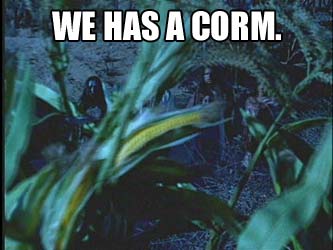 So how many days has it been? Well, there's a helpful sign in the heavens: with each day that passes, the sun, uhhh... undergoes mitosis. That's right: each day, there's another sun up in the sky. By the fifth day, the sun is a cluster of five identical spheres. You might figure this would occasion some comment as early as Day 2, but... nah. 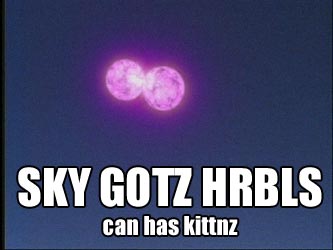 (While we're on the subject of wandering around in confusion, it's never clear why the zombies do the things they do. If they don't realize they're dead, why do they appear to Renee and encourage her to help them find rest? And if they want peace, why do they attack and devour everybody they meet who's not Renee? Sure, it's suggested onbliquely that Renee's frail mental state may give her some connection to the undead, but more needed to be made of this for it to be convincing.) Now, in the meantime, Renee has gone out for a walk and has run into a guy named Michael, who runs the nearby windmill farm. Michael is played by writer/ producer/ director David Heavener himself, so we probably shouldn't be surprised that Renee finds him irresistably attractive. As for Michael? He can't stop staring at Renee's Hero Twins. The movie wants us to believe that Renee has the sheer gall to invite Michael to dinner with her and her fiancé. And dinner tuns out to be as uncomfortable as you'd expect it to be: everybody has a little too much wine, and Renee starts unburdening herself to Michael — much to Jeff's distress. It's here that Renee gives the audience most of her back-story, in the form of raw, expository dialogue. Jeff is horribly hurt over the fact that his pretty young girlfriend is throwing herself at some chiseled hunk o' manliness — and, of course, we now know that his interest in Renee seems almost predatory in nature, anyway. So under the influence of the alcohol and his own injured vanity, he rapes her as soon as Michael has left. As awful as this is, it's one of the the best-handled portions of the film. Now that we know something more about Jeff's motivations, this sort of behavior seems in-character. Also, much more is implied than is shown: before things get too exploitative, we cut away to a montage of atmospheric locations around the house, as though to suggest Renee's mind is retreating from the horror and betrayal she's experiencing. But then, the film does a retreat of its own: we suddenly find ourselves plunged into another of Renee's dreams, and this time, instead of being molested by her creepy fiancé, she's having sweaty snugglebunnies with 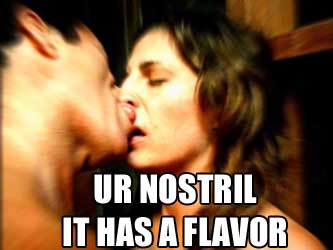 And then it actually gets worse: Renee wakes up and finds out it wasn't a dream. She's run off from being attacked by her erstwhile fiancé, and had semi-conscious sex with a guy she just met. You'd think this would be enough to send her over the edge, especially given that she's supposed to be off her medication and tormented by visions of the walking dead. Not to worry, though: our Michael is here to comfort her. "I think you're just fine," he says... ...to the woman who's off her medication, tormented by visions of the walking dead, and who's now had semi-conscious sex with a guy she just met after being attacked by her erstwhile fiancé!
(nghhhhhhhhhh.... my disgust: let me show it you.)
Naturally, this turn of events sets up a very uncomfortable situation when Renee returns home — and perhaps, in a better movie, the resulting tension would give some depth to the rest of the story. Not here, though. Jeff only has time for a stammered half-apology before he's torn limb from limb by the zombies — and Renee doesn't even hear the attack, because she has the vacuum on (!). As Renee barely manages to get out of the house alive, Michael shows up out of nowhere with a shotgun and buys them both some time to run away. The pair barricade themselves in the barn, while the five hungry Mayan zombies pound at the doors. And then, the pregnant zombie goes into labor... Viewers who are still awake at this point may notice that a certain important plot development has just been foreshadowed. I'll leave it to you to figure out what it is, though it shouldn't be too difficult. Suffice it to say that Heavener, having cast himself as the movie's stud-muffin and given himself the movie's best lines, does go to some length to make up for his apparent narcissim. It's this particular plot point that allows the movie to go on way beyond its logical conclusion. But it also sets up the amazing "baby-whomping" scene, so I can't complain too much: 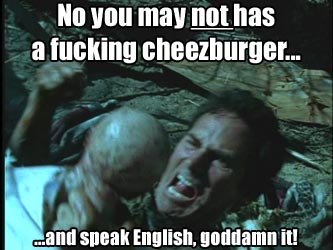 But it's unfortunately true that after the main portion of the film has been wound up — when the zombies have been reminded of their mortality by being led to the Mystical Corn Field, where their personal belongings have been arranged under wooden crosses2 — the movie goes into an extended epilogue. And in this epilogue, the normal rules of time, space and narrative no longer apply. A character who has been killed by a zombie comes back has a zombie himself — although no other victim of the undead has returned... in fact, it's been supposed all along that only true believers of the ancient Mayan faith return as zombies. There might be a reason for this, if we strain our imaginations... but even so, we'd be hard-pressed to explain why, mere minutes after this character's undeath, a second sun appears in the sky. Nor can we figure out why the Lords of the Dead decide to get in on the act at least three days early: maybe they're as impatient as we are for the movie to end. But even after this epilogue, we still have an epilogue-after-the-epilogue to endure. Although this adds little to the story, I'm grateful to it for one thing: it deals directly with something I've always wondered about, in these films that involve the supernatural beliefs of ancient cultures. Movies like this one seem to imply that all modern religions are entirely mistaken, and that the gods of some ancient, long-forgotten polytheistic sect are in fact the true ones. That's a delightfully disturbing notion, and I'm surprised more people haven't mentioned it in the context of other films like, say, The Mummy (any version). In this case, the second epilogue shows us that one of the movie's survivors has paid attention to this lesson, and has become a devotee of the old Maya beliefs. Unfortunately, this second epilogue trails off into a bad joke, in which a little girl channels the unwelcome spirit of middle-period Freddy Krueger... which suggests that the editors were getting punch-drunk before they finished the job. And we're still some ten minutes short of the stated 90-minute running time... There isn't much more I can say about this movie that wouldn't come off sounding as tired and half-hearted as I found the movie itself to be. But I'd like to end this review on a positive note, so I'm happy to say Dawn of the Living Dead saves its best gesture for very last. Over the closing credits plays a little ditty Heavener wrote, called The Mombie Zombie: it's as concise, unassuming and genuinely funny as the movie itself is not. It has lyrics like "First she stole my heart, and then she took my lungs...", and its refrain goes like this:
Do the Mombie Zombie! (chomp chomp chomp)
Do the Mombie Zombie! (chomp chomp chomp) It's the dance of the dead, and everybody's doin' it — Grabbin' body parts, and a-chew, chew, chewin' it! ... which, in spite of its grammatical problems, still has a sense of fun that is sorely missing from the production as a whole. 1. I imagine most of you know who Todd Bridges is: he was the front man for the Todd Bridges Experience. I think he also did some television at one time... < Back 2. Wait a minute: crosses??! Yeah; I'm sure that's not going to piss off any central American deities... < Back |